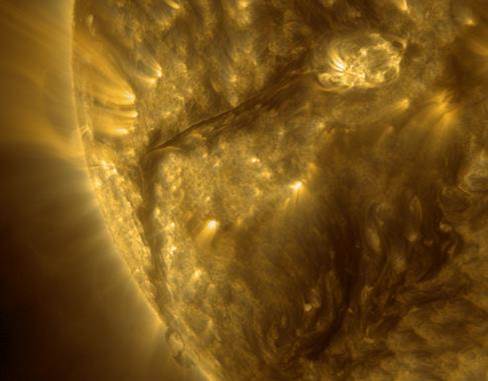A movie of the transit of the filament and its almost eruption on 04 February 2015 in both H-alpha and EUV is available here.

Solar filaments are clouds of ionized gas above the solar surface squeezed between magnetic regions of opposite polarity. Being cooler and denser than the plasma underneath and their surroundings, they appear as dark lines when seen on the solar disk and as bright blobs when seen near the solar limb (then they are called "prominences"). Special filters are required to observe these features, and one such a filter is the Hydrogen-alpha (H-alpha) line in the red part of the solar spectrum. It shows the cool inner atmosphere of the Sun. The image underneath at left shows a very long filament that started to transit the Sun early last week. It neatly fills the transition zone between the two large patches of opposite magnetic polarity as can be seen on the image to the right: black (negative) on the left (east), white (positive) on the right (west).

This filament started to appear around 02 February at the east limb. Gradually, the solar rotation moved it further onto the earth-facing solar hemisphere. It was so long that it took almost a full week before it could be seen in its entirety. It was well over 1 million km long, or the equivalent of at least 2.5 times the Earth-Moon distance. The height of the filament appears to correspond to about 3.5 Earth diameters (+/- 43.000 km), which is no exceptional value.

However, the length of the filament is something we do not see every day, but it is also not the first time we see such a long structure. For example, a slightly shorter filament was visible early 2005 and lasted for over 3 full solar rotations. The images underneath show the filament on 22 February, 21 March, and 17 April 2005. Other examples of (very) long filaments were discussed in this STCE news item.

Though most of these long filaments eventually erupt, this does not necessarily have to be the case. A lot depends on the stability of the surrounding magnetic fields. The presence and flaring activity in nearby active regions may disturb these fields and these destabilize the filament which may then erupt. Interestingly, in this case, there is an active region (NOAA 12280) at the west end of the filament. Early this week, the filament hardly survived a not so strong flare from this region. The C3 flare peaked at 19:12UT on 04 February and destabilized a substantial part of the filament. In just an hour or two, the filament reshaped itself. See this news item for other examples.

Hot off the press - The southeastern ("lower left") part of the filament graciously erupted during the evening hours of 11 February. The eruption was not associated to an obvious x-ray flare or proton flux enhancement. Current coronagraphic images reveal no obvious coronal mass ejection.
Credits - Data and imagery for the movie clips were taken from the GONG H-alpha network, SDO, and (J)Helioviewer.
 |
 |





